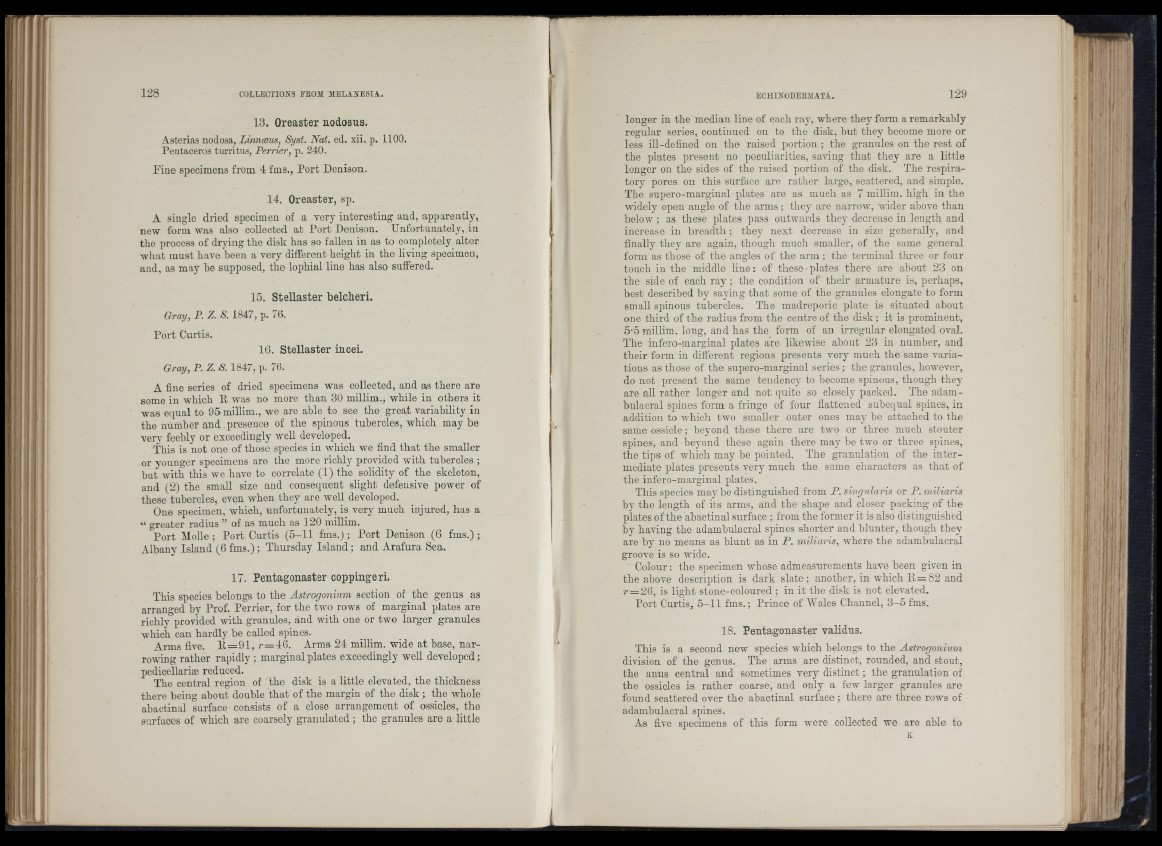
: |I
î i î
îil'
1 i
4 “
7 1 !
: n i
7 , :
1 I 1’
I iJ
(
13. Oreaster nodosus.
Asterias nodosa, Linnæus, Sgst. Nat. ed. xii. p. 1100.
Pentaceros turritus, Perrier, p. 240.
Pine specimens from 4 fms.. Port Denison.
14. Oreaster, sp.
A single dried specimen of a verj^ interesting and, apparently,
new form was also collected at Port Denison. Unfortunately, in
the process of drying the disk has so fallen in as to completely alter
what must have been a very different height in the living specimen,
and, as may he supposed, the lophial line has also suffered.
15. Stellaster belcheri.
Grag, P. Z. S. 1847, p. 76.
Port Curtis.
16. Stellaster incei.
Grag, P. Z. S. 1847, p. 76.
A fine series of dried specimens was collected, and as there are
some in which E, nms no more than 30 millim., while in others it
was equal to 95 millim., we aro able to see the great variability in
the number and presence of the spinous tubercles, which may be
very feebly or exceedingly well developed.
This is not one of those species in which we find th at the smaller
or younger specimens are the more richly provided with tubercles ;
but with this we have to correlate (1) the solidity of the skeleton,
and (2) the small size and consequent slight defensive power of
these tubercles, even when they are well developed.
One specimen, which, unfortunately, is very much injured, has a
“ greater radius” of as much as 120 millim.
Port Molle ; Port Curtis (5-11 fms.) ; Port Denison (6 fms.) ;
Albany Island (6 fms.) ; Thursday Island ; and Arafura Sea.
17. Pentagonaster coppingeri.
This species belongs to the Astrogonium section of the genus as
arranged by Prof. Perrier, for the two rows of marginal plates are
richly provided with granules, and with one or two larger granules
which can hardly be called spines.
Arms five. 11=91, r = 46. Arms 24 millim. wide at base, narrowing
rather rapidly; marginal plates exceedingly well developed;
pedicellariæ reduced.
Tho central region of the disk is a little elevated, the thickness
there being about double th at of the margin of the disk ; the whole
ahactinal surface consists of a close arrangement of ossicles, the
surfaces of which are coarsely granulated ; the granules are a little
longer in the median line of each ray, where they form a remarkably
regular series, continued on to the disk, hut they become more or
less ill-defined on tho raised portion ; the granules on the rest of
the plates present no peculiarities, saring th at they are a little
longer on the sides of the raised portion of the disk. The respiratory
pores on this surface are rather large, scattered, and simple.
The supero-marginal plates are as much as 7 millim. high in the
widely open angle of the arms ; they are narrow, wider above than
below ; as these plates pass outwards they decrease in length and
increase in breadth ; they next decrease in size generally, and
finally they are again, though much smaller, of the same general
form a.s those of the angles of the arm ; the terminal three or four
touch iu the middle line : of these plates there are about 23 on
the side of each ray ; the condition of their armature is, perhaps,
best described by saying th at some of the granules elongate to form
small spinous tubercles. The madreporic plate is situated about
one third of the radius from the centre of the disk ; it is prominent,
5-5 millim. long, and has the form of an irregular elongated oval.
The infero-inarginal plates are likewise about 23 in number, and
their form in different regions presents very much the same variations
as those of the snpero-marginal series ; the granules, however,
do not present the same tendency to become spinous, though they
are all rather longer and not quite so closely packed. The adamhulacral
spines form a fringe of four fiattened subeqnal spines, in
addition to which two smaller outer ones may he attached to the
same ossicle ; beyond these there are two or three much stouter
spines, aud beyond these again there may be two or three spines,
the tips of which may be pointed. The granulation of the in te rmediate
plates presents very much the same characters as th at of
the infero-marginal plates.
This species may he distinguished from P. singularis or P. miliaris
by the length of its arms, and the shape and closer packing of the
plates of the abactinal surface ; from the former it is also distinguished
by having the adamhulacral spines shorter and blunter, though they
are by no means as blunt as in P. miliaris, where the adamhulacral
groove is so wide.
Colour : the specimen whose admeasurements have been given in
the above description is dark slate; another, in which 11 = 82 and
r = 26, is light stone-coloured ; in it the disk is not elevated.
Port Curtis, 5-11 fms. ; Prince of AAHles Channel, 3 -5 fms.
18. Pentagonaster validus.
This is a second new species which belongs to the Astrogonium
division of the genus. The arms are distinct, rounded, and stout,
the anus central and sometimes very distinct ; the granulation of
the ossicles is rather coarse, and only a few larger granules are
found scattered over the abactinal surface ; there are three rows of
adamhulacral spines.
As five specimens of this form were collected we are able to
K
I i! I
! (ii
r